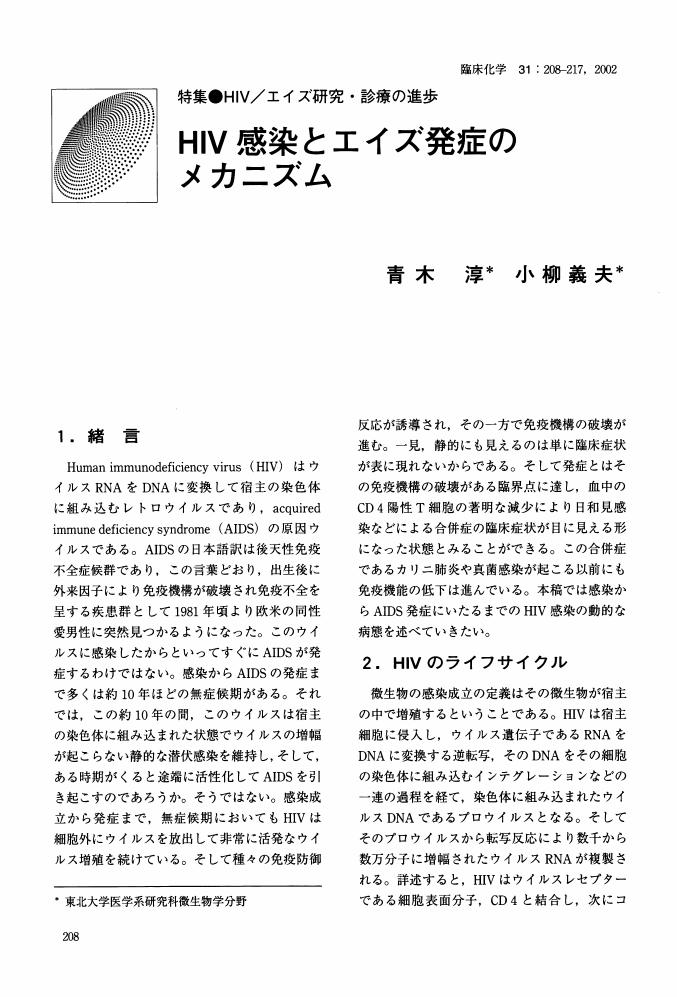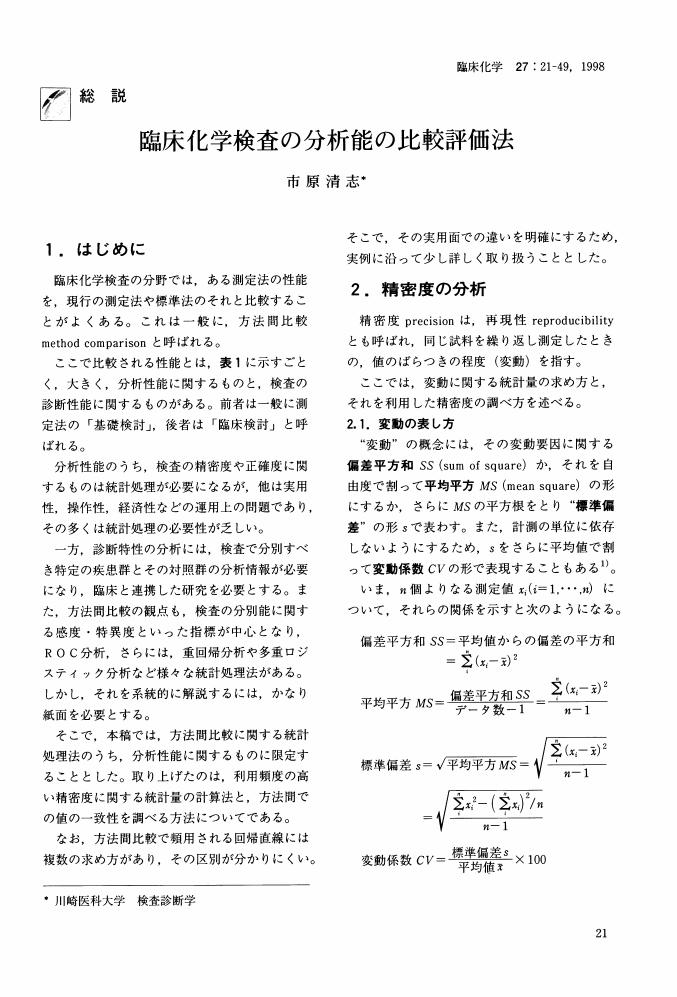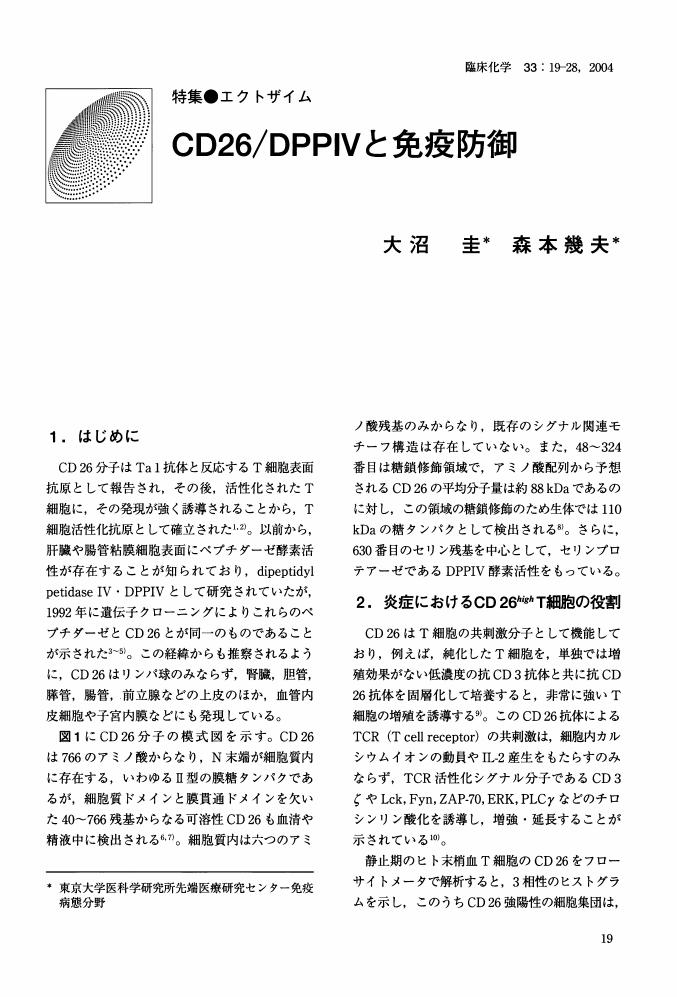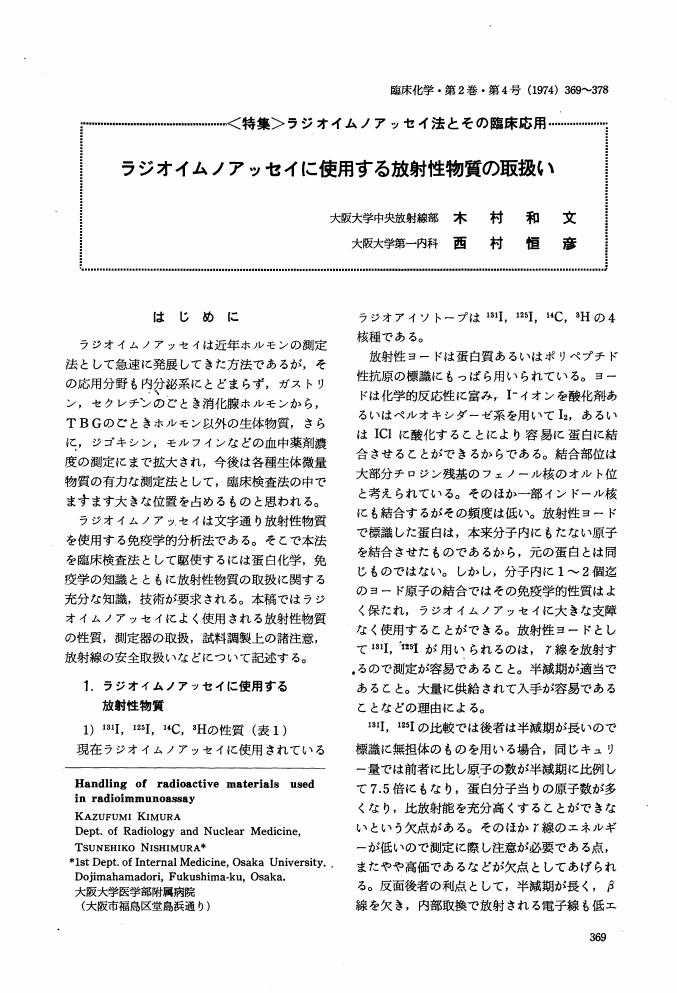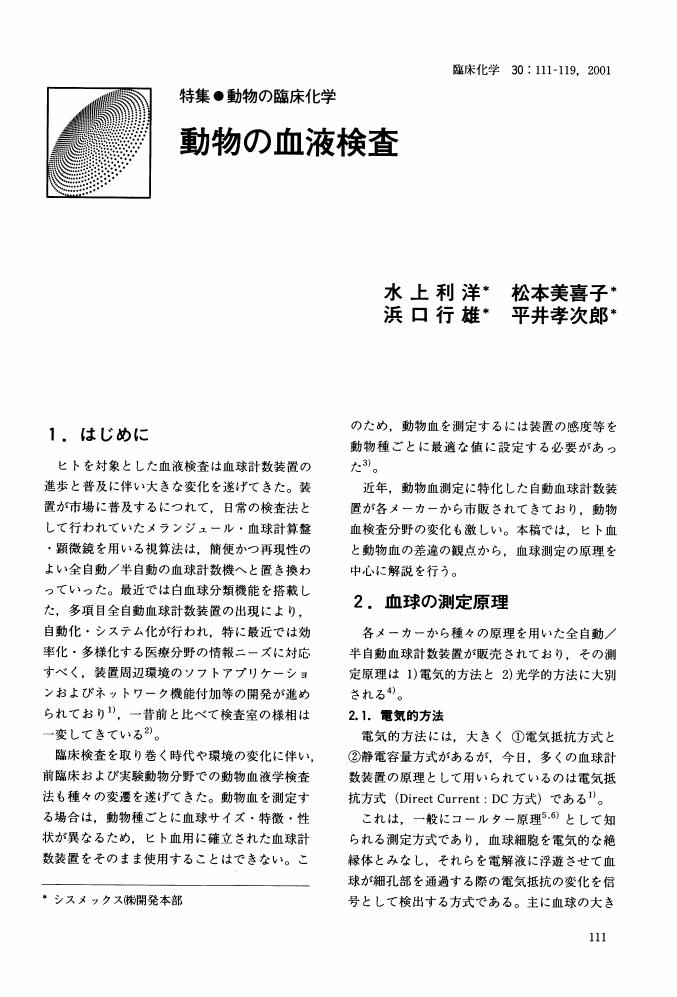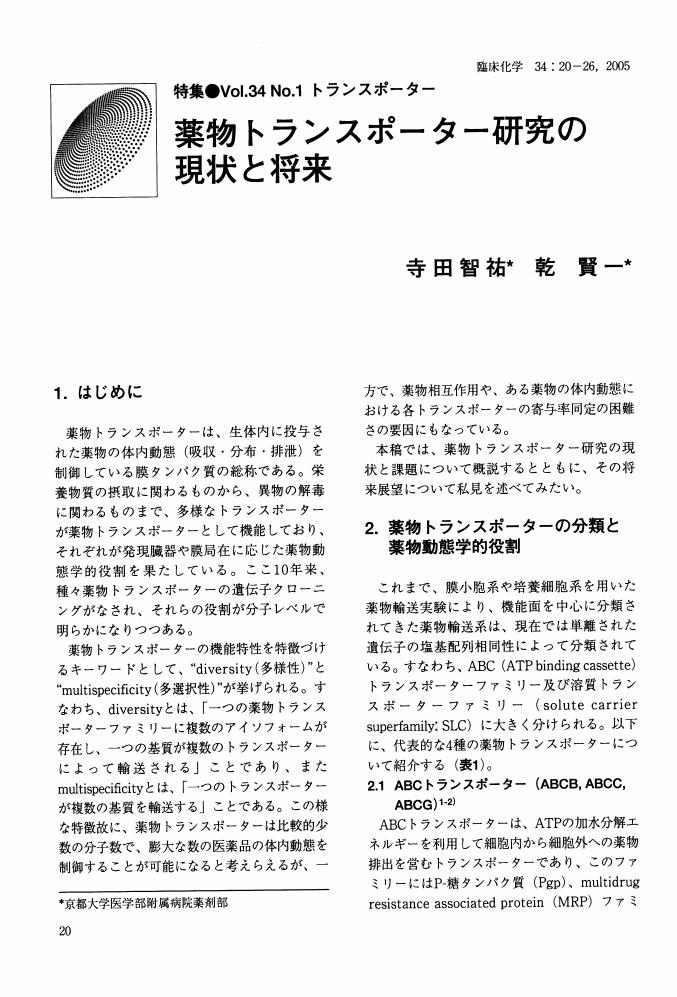18 0 0 0 OA HIV感染とエイズ発症のメカニズム
- 著者
- 青木 淳 小柳 義夫
- 出版者
- 一般社団法人 日本臨床化学会
- 雑誌
- 臨床化学 (ISSN:03705633)
- 巻号頁・発行日
- vol.31, no.4, pp.208-217, 2002-12-31 (Released:2012-11-27)
- 参考文献数
- 23
15 0 0 0 OA 臨床化学検査の分析能の比較評価法
- 著者
- 市原 清志
- 出版者
- 一般社団法人 日本臨床化学会
- 雑誌
- 臨床化学 (ISSN:03705633)
- 巻号頁・発行日
- vol.27, no.1, pp.21-49, 1998-03-31 (Released:2012-11-27)
- 参考文献数
- 17
- 被引用文献数
- 1
11 0 0 0 OA ステロイドホルモンの生合成と代謝
- 著者
- 猪川 嗣朗
- 出版者
- 一般社団法人 日本臨床化学会
- 雑誌
- 臨床化学 (ISSN:03705633)
- 巻号頁・発行日
- vol.29, no.1, pp.2-14, 2000-03-31 (Released:2012-11-27)
- 参考文献数
- 5
- 被引用文献数
- 1
5 0 0 0 OA アルカリホスファターゼの構造と機能
- 著者
- 石田 陽子 小丸 圭一 織田 公光
- 出版者
- 一般社団法人 日本臨床化学会
- 雑誌
- 臨床化学 (ISSN:03705633)
- 巻号頁・発行日
- vol.33, no.1, pp.36-44, 2004-03-31 (Released:2012-11-27)
- 参考文献数
- 32
- 被引用文献数
- 1
4 0 0 0 OA 経口避妊薬とステロイドホルモン動態
- 著者
- 原田 省
- 出版者
- 一般社団法人 日本臨床化学会
- 雑誌
- 臨床化学 (ISSN:03705633)
- 巻号頁・発行日
- vol.29, no.1, pp.53-60, 2000-03-31 (Released:2012-11-27)
- 参考文献数
- 4
- 被引用文献数
- 1
4 0 0 0 OA トランスポーターの遺伝子多型と臨床
- 著者
- 家入 一郎
- 出版者
- 一般社団法人 日本臨床化学会
- 雑誌
- 臨床化学 (ISSN:03705633)
- 巻号頁・発行日
- vol.34, no.1, pp.5-10, 2005-03-31 (Released:2012-11-27)
- 参考文献数
- 10
4 0 0 0 OA A-6. 生体試料の超微弱発光各種疾患患者血液の超微弱発光を中心として
- 著者
- 依田 敏行 後藤 由夫
- 出版者
- 一般社団法人 日本臨床化学会
- 雑誌
- 臨床化学シンポジウム (ISSN:03863417)
- 巻号頁・発行日
- vol.21, pp.20-22, 1982-07-15 (Released:2012-11-27)
- 参考文献数
- 7
The detecting ability of the photon counting system of single photoelectron counting method has been greatly improved and an equipment of this method, designed for biochemical and biomedical applications, was developed. The photomultiplier used in the instrument was of bialkali photocathode of 5cm diameter with the spectral responce nearly from 300nm to 660nm and of specifically low noise selected from hundreds of the same photomultipliers. The photomultiplier was cooled down to -20° in the equipment in the actual photon counting for the further reduction of the noise. All other possible electrical noises from the inside and the outside of the counting machine were eliminated or minimized. The sensitivity of the photon counting equipment reached the level high enough to permit the determination of extremely weak light emission like those of human blood and tissue samples. Thus, the first quantitative measurement, to our knowledge, of ultra weak chemiluminescence of human blood samples was performed with this instrument. The whole blood and plasma samples of normal subjects gave relatively low levels of light emission. On the contrary, the blood samples of patients with diabetes mellitus and with liver diseases showed significantly higher light emission levels. Of particular interest was of the blood of patients with obstructive jaundice and of severe hepatitis. The light emission of the blood samples of these disease was generally very high and in the levels allowing the spectral analysis of the emitted light.The analysis and the scavenger experiments indicated the contribution of singlet oxygen as the photon emitting entity in these blood samples.
3 0 0 0 OA 糖尿病患者における好中球活性酸素産生能について
- 著者
- 菅野 和久 徳永 賢治 越智 正昭 宍野 宏治 村瀬 光春 佐伯 修一 武内 望 篠原 力雄 石黒 伊三雄
- 出版者
- 一般社団法人 日本臨床化学会
- 雑誌
- 臨床化学 (ISSN:03705633)
- 巻号頁・発行日
- vol.22, no.3, pp.168-172, 1993-09-30 (Released:2012-11-27)
- 参考文献数
- 12
- 被引用文献数
- 3
糖尿病患者における合併症や易感染性の原因とその機序を解明する目的でphorbo-myristateacetate刺激時 (PMA) およびオプソニン化チモーザン刺激時 (OZ) の好中球活性酸素産生能を測定し, さらに血中糖化タンパク (HbA1c, フルクトサミン) 濃度との関連性を調べた。糖尿病患者はPMA, OZ両者ともに健常人と比較して好中球活性酸素産生能の低下傾向を示し, PMAではp<0.01で有意に低下した。また血中糖化タンパク濃度との相関性は認められなかったが, 空腹時血糖値とは負の相関性 (r=-0.500, p<0.05) を認めた。健常人血液へのグルコース添加実験で好中球活性酸素産生能は20から50mmol/lまでは有意 (p<0.05) に低下傾向を示した。以上より, 好中球活性産生能は高血糖状態を示す糖尿病患者で低下しており, 好中球機能障害の要因となることが示唆された。このことは, 糖尿病患者好中球に存在するreduced nicotinamide adenine dinucleotide phosphate (NADPH) の減少が原因と考察した。
3 0 0 0 OA 腎臓の糖新生とその特異性
- 著者
- 坪内 博仁 中川 八郎
- 出版者
- 一般社団法人 日本臨床化学会
- 雑誌
- 臨床化学 (ISSN:03705633)
- 巻号頁・発行日
- vol.7, no.2, pp.101-109, 1978-12-25 (Released:2012-11-27)
- 参考文献数
- 28
2 0 0 0 OA CD26/DPPIVと免疫防御
- 著者
- 大沼 圭 森本 幾夫
- 出版者
- 一般社団法人 日本臨床化学会
- 雑誌
- 臨床化学 (ISSN:03705633)
- 巻号頁・発行日
- vol.33, no.1, pp.19-28, 2004-03-31 (Released:2012-11-27)
- 参考文献数
- 54
- 被引用文献数
- 1
2 0 0 0 OA 細胞の電磁波環境に対する応答機構
- 著者
- 宮越 順二
- 出版者
- 一般社団法人 日本臨床化学会
- 雑誌
- 臨床化学 (ISSN:03705633)
- 巻号頁・発行日
- vol.31, no.3, pp.168-178, 2002-09-30 (Released:2012-11-27)
- 参考文献数
- 55
2 0 0 0 OA T-3. MONのウイルス学的研究
- 著者
- 井上 幸重 西部 陽子 中村 良子
- 出版者
- 一般社団法人 日本臨床化学会
- 雑誌
- 医化学シンポジウム (ISSN:03863387)
- 巻号頁・発行日
- vol.10, pp.81-84, 1971-07-20 (Released:2012-11-27)
- 参考文献数
- 3
In recent years, there have been many patients in Japan suffering from subacute myelo-optico-neuropathy (SMON) following abdominal disorders. At present, its etiology is not known, however, there are a few kinds of etiological hypotheses. One is that SMON may be a toxicosis caused by oral administration of chinoform, which have many contradictions in explaining the disease. Another is our viral etiological hypothesis, and the present report deals with isolation and some propertiesof the suspect virus present in stools and spinal fluid of SMON patients.Virus was isolated, with a high frequency, in BAT-6 cell cultures accompanying a weak and incomplete cytopathic effect (CPE) from feces and spinal fluid of SMON patients living in different prefectures. Attempts to isolate the virus accompanying CPE in HeLa cells, primary monkey kidney cells, and human embryonic kidney cells were all unsuccessful. On the other hand, no virus was isolated in BAT-6 cells from control specimens except the case of aseptic meningitis. Antiserum prepared from the virus isolated from feces neutralized not only the CPE produced by other viruses from stool but also the CPE produced by all viruses from the spinal fluid of SMON patients.Neutralizing antibody (NT) titers of 13 among 15 sera collected from SMON patients on different days after the onset of the disease were 5 to 10. In contrast, 10 sera collected from normal adults showed NT titer less than 5. Failure to detect high NT titers in patients sera may explain the subacute course and relapse of the disease. Furthermore, convalescent sera of two cases of aseptic meningitis showed NT titer of 160 to 320. The fact suggests that SMON may be a new viral infection following insufficient immunological state.BAT-6 cells were found to be not susceptible to human enteroviruses so far tested, and the virus showed a characteristic host range in tissue culture. The virus was sensitive to ether, and 5-iodo-2'-deoxyuridine. Also, the virus was filtrable through a membrane filter with an average pore size of 220mμ, but the virus was unable to pass through a 100mμ pore filter. Studies on pathogenicity of the virus in mice are revealing that the virus seems to be a new neuropathic slow virus. Further investigations about the properties of the virus are now in progress.
2 0 0 0 OA ラジオイムノアッセイに使用する放射性物質の取扱い
- 著者
- 木村 和文 西村 恒彦
- 出版者
- 一般社団法人 日本臨床化学会
- 雑誌
- 臨床化学 (ISSN:03705633)
- 巻号頁・発行日
- vol.2, no.4, pp.369-378, 1974-03-25 (Released:2012-11-27)
- 参考文献数
- 9
2 0 0 0 OA グリコーゲンの構造と研究法
- 著者
- 檜作 進
- 出版者
- 一般社団法人 日本臨床化学会
- 雑誌
- 臨床化学 (ISSN:03705633)
- 巻号頁・発行日
- vol.2, no.3, pp.316-325, 1973-12-25 (Released:2012-11-27)
- 参考文献数
- 51
2 0 0 0 OA 脳内胆汁酸の由来と機能
- 著者
- 眞野 成康 後藤 貴章 阿部 幸平
- 出版者
- 一般社団法人 日本臨床化学会
- 雑誌
- 臨床化学 (ISSN:03705633)
- 巻号頁・発行日
- vol.36, no.3, pp.189-196, 2007-07-31 (Released:2012-11-27)
- 参考文献数
- 24
2 0 0 0 OA 動物の血液検査
- 著者
- 水上 利洋 松本 美喜子 浜口 行雄 平井 孝次郎
- 出版者
- 一般社団法人 日本臨床化学会
- 雑誌
- 臨床化学 (ISSN:03705633)
- 巻号頁・発行日
- vol.30, no.3, pp.111-119, 2001-09-30 (Released:2012-11-27)
- 参考文献数
- 25
- 被引用文献数
- 1
1 0 0 0 OA 2型糖尿病原因遺伝子同定へのアプローチ
- 著者
- 原 一雄 戸辺 一之 赤沼 安夫 門脇 孝
- 出版者
- 一般社団法人 日本臨床化学会
- 雑誌
- 臨床化学 (ISSN:03705633)
- 巻号頁・発行日
- vol.30, no.1, pp.20-27, 2001-03-31 (Released:2012-11-27)
- 参考文献数
- 15
1 0 0 0 OA オルニチン代謝疾患の分子病態生化学
- 著者
- 松澤 健夫 伊藤 光泰 長坂 顕雄 笠原 正男
- 出版者
- 一般社団法人 日本臨床化学会
- 雑誌
- 臨床化学 (ISSN:03705633)
- 巻号頁・発行日
- vol.29, no.3, pp.94-102, 2000-09-30 (Released:2012-11-27)
- 参考文献数
- 22
1 0 0 0 OA ファルネソイドX受容体を介した胆汁酸による生理機能の制御
- 著者
- 頭金 正博
- 出版者
- 一般社団法人 日本臨床化学会
- 雑誌
- 臨床化学 (ISSN:03705633)
- 巻号頁・発行日
- vol.35, no.2, pp.136-143, 2006-04-28 (Released:2012-11-27)
- 参考文献数
- 34
コレステロールから生合成される胆汁酸は, 胆汁の主な構成成分として小腸での脂質の吸収を促進するなどの界面活性剤として生理機能を発揮していると考えられてきたが, 1999年になって胆汁酸が核内受容体の一種であるファルネソイドX受容体 (FXR) のリガンドとして機能することが明らかになった。この研究を契機として, 胆汁酸の新規機能に関する研究が大きく展開し, 胆汁酸はFXRを介して胆汁酸生合成の律速酵素であるチトクロムP450 7Alの発現を制御しているのみならず, 胆汁酸の腸管循環を制御している胆汁酸トランスポーター等の発現を制御していることが明らかになった。また, 最近ではFXRを活性化することによって, 糖尿病マウスでの高血糖や高脂血症を改善することが報告され, 胆汁酸は胆汁酸生合成や腸管循環の制御のみならず脂質代謝や糖代謝も制御している可能性が指摘されている。
1 0 0 0 OA 薬物トランスポーター研究の現状と将来
- 著者
- 寺田 智祐 乾 賢一
- 出版者
- 一般社団法人 日本臨床化学会
- 雑誌
- 臨床化学 (ISSN:03705633)
- 巻号頁・発行日
- vol.34, no.1, pp.20-26, 2005-03-31 (Released:2012-11-27)
- 参考文献数
- 31
